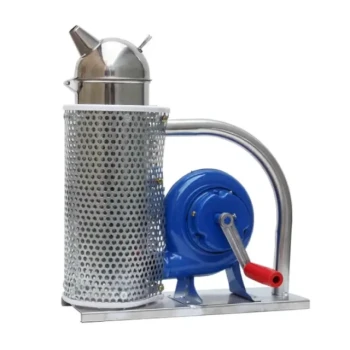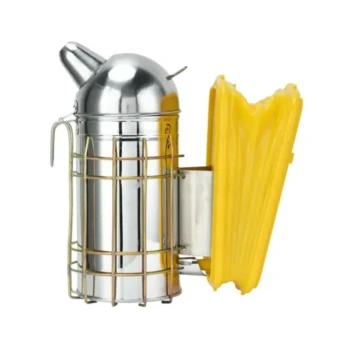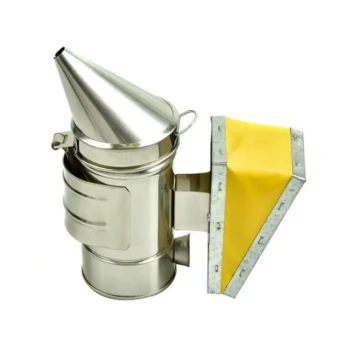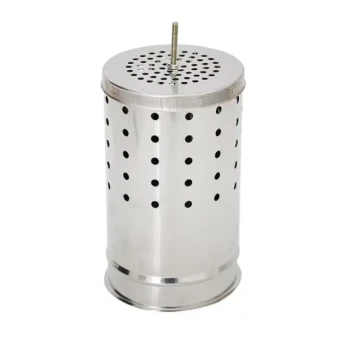From the earliest documented interactions, humans have used smoke to manage honey bee colonies. The first beekeepers utilized simple clay pots filled with smoldering fuel. They would ignite the material and then manually blow through an opening in the pot to direct the smoke toward the hive entrance, a basic but effective method for calming the bees before tending to the hive.
The specific tool has evolved from a simple clay pot to a modern bellows-driven device, but the core principle remains unchanged: using smoke to interrupt the bees' defensive communication and make the colony more docile for inspection.
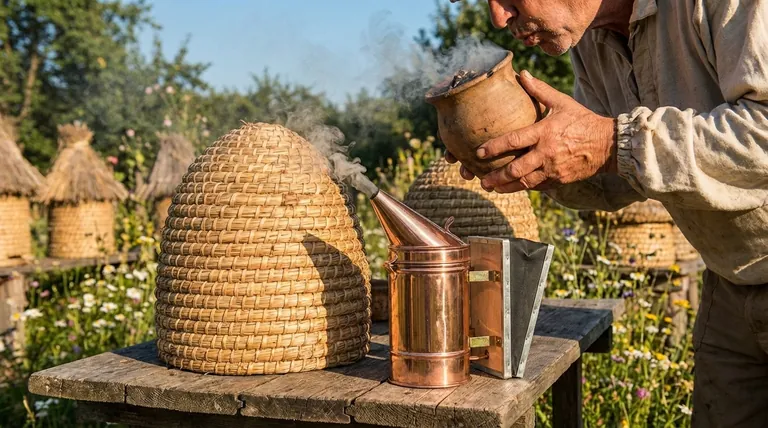
The First Smokers: A Simple and Effective Design
The design of the earliest bee smokers, as depicted in ancient art and confirmed by archaeological findings, was elegantly simple. It relied on basic materials and the beekeeper's own breath.
The Clay Pot as a Tool
The primary tool was a fired clay pot, often with a small chamber to hold fuel and one or more openings. This vessel was durable, heat-resistant, and easy to construct from widely available materials.
The Fuel Source
Beekeepers would pack the pot with slow-burning natural materials. This commonly included dried leaves, rotten wood, dried dung, or other organic matter that would produce a cool, dense smoke rather than a hot flame.
The Application Method
Unlike modern smokers that use bellows to pump air, the early beekeeper provided the force themselves. By blowing into one opening of the pot, they forced the smoke out of another, directing it toward the colony's entrance and any open seams in the hive structure.
The Underlying Principle: Why Smoke Works
The use of smoke is not arbitrary; it leverages the bees' natural instincts. This scientific principle is the reason the practice has endured for thousands of years.
Masking Alarm Pheromones
When a bee stings or feels threatened, it releases alarm pheromones. These chemical signals alert other bees in the colony, triggering a coordinated defensive response.
Smoke effectively masks these pheromones. The thousands of particles in the smoke overwhelm the bees' sensitive antennae (their "noses"), making it difficult for them to detect the alarm signals from their hive mates. This prevents a mass defensive reaction.
Triggering a Feeding Response
Smoke also triggers a secondary, more primal instinct. Bees associate the smell of smoke with a potential forest fire, which threatens their hive.
In response, they begin to gorge on honey. Their logic is to load up on as much of their valuable food source as possible in case they need to abandon the hive and build a new one elsewhere. A bee with a full abdomen of honey is physically less able to flex its body to sting and is generally more docile.
Understanding the Limitations of Early Methods
While the principle was sound, the early clay pot method had significant drawbacks compared to modern tools. This evolution highlights a drive for greater control and safety.
Lack of Control and Consistency
Blowing by mouth produces inconsistent puffs of smoke. It was difficult to apply a gentle, steady amount. Too little smoke would be ineffective, while too much could irritate the bees or choke the colony.
Inefficiency and Risk
The method was inefficient, requiring the beekeeper to hold the pot and use their own breath, occupying their hands and lungs. There was also a greater risk of dropping hot embers from the open pot, which could harm the beekeeper or ignite the surrounding area. Modern smokers with bellows and contained fuel chambers are far safer and more efficient.
From Ancient Practice to Modern Beekeeping
Understanding this history reveals the timeless nature of the core principles of apiary management. The goal has always been to work in harmony with the bees' natural behavior.
- If your primary focus is historical accuracy: Early beekeepers used a simple clay pot with ignited fuel, using their own breath to blow smoke toward the hive entrance.
- If your primary focus is beekeeping science: The fundamental purpose of smoke has always been to mask alarm pheromones and trigger a feeding response, making the colony calmer and safer to manage.
This enduring practice is a testament to our ancestors' keen observation of the natural world and their ability to develop tools to work alongside it.
Summary Table:
| Aspect of Early Smoker Use | Key Details |
|---|---|
| Primary Tool | Fired clay pot with a chamber for fuel |
| Fuel Source | Dried leaves, rotten wood, or dung for cool, dense smoke |
| Application Method | Beekeeper blew into the pot to direct smoke |
| Core Principle | Smoke masks alarm pheromones and triggers a feeding response |
| Key Limitation | Inconsistent smoke flow and higher safety risk compared to modern tools |
Upgrade Your Apiary Management with Modern Equipment from HONESTBEE
The principles of beekeeping are timeless, but the tools have evolved for greater safety and efficiency. As a trusted supplier of beekeeping supplies and equipment to commercial apiaries and distributors, HONESTBEE provides the modern, reliable tools you need to manage your colonies effectively.
Whether you're a large-scale commercial operation or a distributor seeking high-quality stock, our wholesale-focused operations ensure you get the best equipment to support your beekeeping success.
Contact HONESTBEE today to discuss your equipment needs and discover how our products can enhance the productivity and safety of your beekeeping practice.
Visual Guide
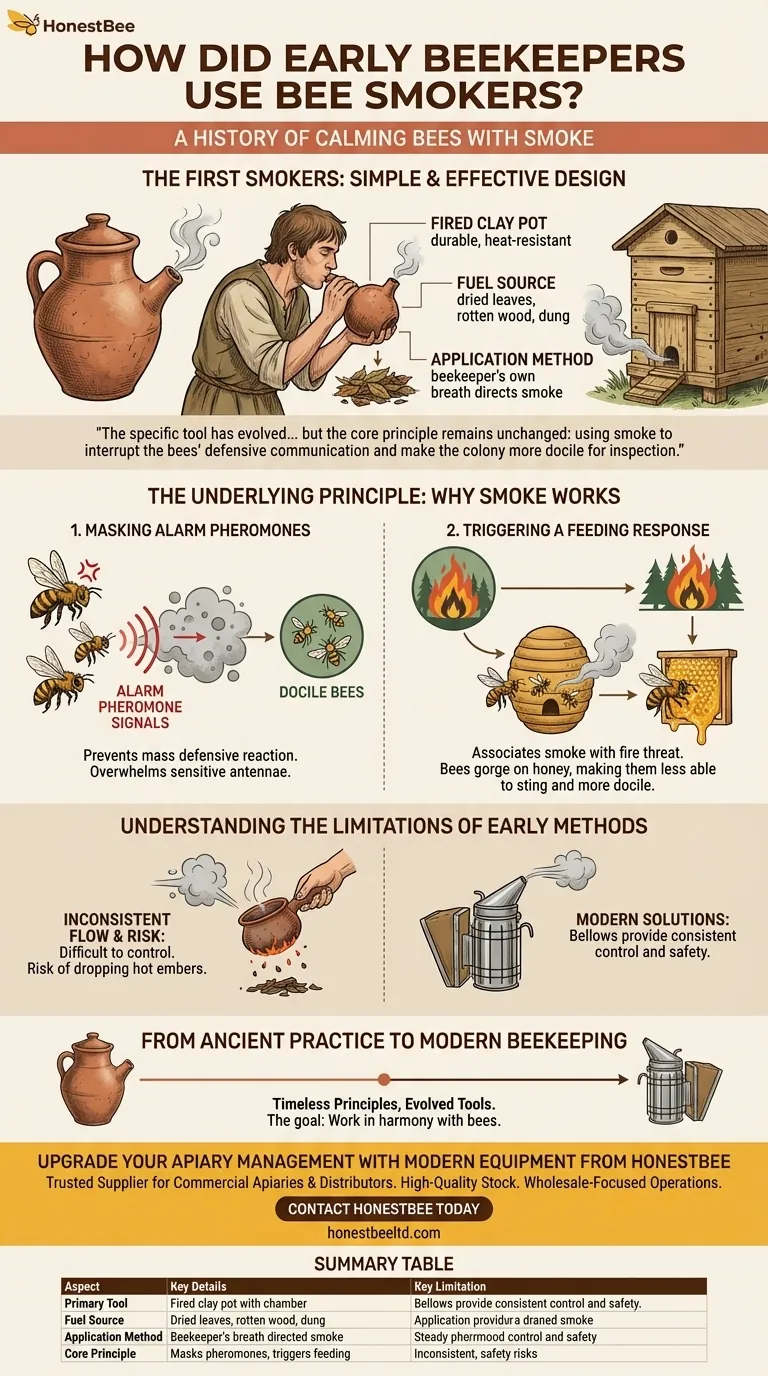
Related Products
- Premium Traditional Copper Bee Smoker with Bellows
- Stainless Steel Honey Bee Smoker Hive and Honeycomb Smoker for Beekeeping
- Economy Galvanized Beekeeping Honey Bee Smoker for Wholesale
- Professional Bee Smoker with Elongated Spout and Durable Bellows for Beekeeping
- European Stainless Steel Bee Smoker for Honey Bee Hive
People Also Ask
- What is the purpose of a bee smoker and how should it be used? A Guide to Calm, Safe Hive Inspections
- What is a Smoker and how is it used in beekeeping? The Essential Tool for Calm, Safe Hive Inspections
- What are some alternatives to using smoke in beekeeping? A Guide to Gentle Hive Management
- What are the benefits of using smoke properly in beekeeping? Achieve Calm, Safe Hive Inspections
- How does water mist work as an alternative to smoke in beehives? A Guide to Safe & Effective Use





